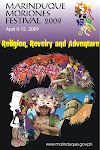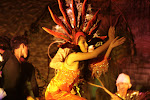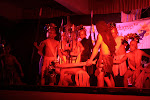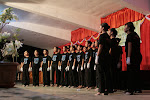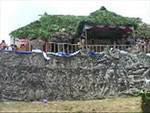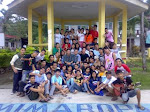Buenavista, Marinduque. Ang Kristo: Pasyondula is a 3-hour passion play first mounted in 2006 by Teatro Balangaw, a Marinduque community theater group. It has been presented since then in Buenavista, Gasan and Boac and this year 2015, returns to the original town where local artists and municipal officials hope to make it an annual Holy Week event in this scenic and laid-back locale at the foot of the mystical Malindig volcano. The 2015 version features Joseph Biggel of PBB as the blind centurion Longinus who regained his sight when blood and water poured from the body of the crucified Christ when he pierced His side with a spear.
Sunday, April 12, 2015
Tuesday, December 08, 2009
Teatro Balangaw Flashbacks
Footages from some productions ca. 1996-2003. In the towns of Boac, Gasan and Buenavista the community theater group Teatro Balangaw has mounted original productions based on folk beliefs in the island-province of Marinduque.
"Mara Unduk", "Bulong", "Moryonan" and "Sukat Ipag-alab ng Damdamin" are some such productions presented in the form of dance-dramas.
It's exactly 17 years today when Teatro Balangaw mounted its very first production, "Mara Unduk" at the Boac Covered Court on December 8, 1992, to culminate the different festivities related to the town fiesta celebration. The faces of Triumph and Tragedy loomed...
Labels:
Bulong,
Mara-Unduk,
Moryonan,
Sukat Ipag-Alab ng Damdamin
Sunday, November 22, 2009
1st Lupac Fiesta
Old Teatro Souvenir Program
Saturday, June 27, 2009
TEATRO BALANGAW AT SANGGUNIANG PANLALAWIGAN
The new governor of Marinduque requested the Teatro Balangaw group to perform the doxology in connection with his 1st 100 days report on September 15, 2007. He specifically wanted a presentation that underlined unity and togetherness. We were hesitant because we had only two days to do it, but had to accede. We picked out some members from Bangbang National High School who were part of the "Awit sa Pulang Lupa" presentation on September 13 or just two days earlier. With such little preparation I had to deliver the invocation myself.
Tuesday, June 23, 2009
VIVA MARINDUQUE SLIDESHOW
One of Teatro Balangaw's major projects during the last two years is the production of "Viva Marinduque" showcasing various aspects of Marinduque culture. This involves cooperation with the provincial government, the six municipalities, cultural agencies such as the National Commission for Culture & the Arts (NCCA), local cultural organizations, academic institutions and various agencies. This slideshow features photos of actual performances and behind-the-scene lighter moments with the 2008 and 2009 cast.
Saturday, June 06, 2009
Wednesday, August 06, 2008
Wednesday, October 17, 2007
Friday, December 16, 2005
Monday, April 11, 2005
TEATRO BALANGAW: Quo Vadis?
2005: QUO VADIS BALANGAW?
There is a notion that community theaters like those in America are “where people's most base elements thrive: egos exalted, fed, stroked, and patted; jealousies run rampant; tantrums tolerated and considered part of the culture; where strangers come together--for nothing profitable, nothing useful, nothing tangible or lasting, for nothing more than such stuff as dreams are made of--all because of some unnamable desire to imagine themselves into other people's stories and relate those stories to others.” (Cohen, 2001)
But Balangaw never was a place for that. Here, egos are deflated before they attempt to reach the skies; jealousies discouraged; tantrums are never tolerated as they are considered not part of the culture; where strangers come and are told that they have a responsibility to change the situations around them that make their lives miserable; that they can effect positive changes in society, but that it starts with them; that we have come together to prove to the community that not all have accepted their fate as slaves or serfs in such a feudalistic island; that we have a responsibility to those who will come after us and those after them and must strive to cease the wanton destruction of our environment; that the vain desire to just imagine themselves into other people’s stories is not art but just an illusion; that our work is nothing if it does not serve a greater social purpose.
At Balangaw no one has sought recognition for his/her work except a few – those who continue to harbor blind, grandiose, illusory thoughts of epical greatness about themselves - who turn up at moments of victory to seize and steal the moment from those who have labored - hard against many odds - for their art, their creation. (to be continued)
There is a notion that community theaters like those in America are “where people's most base elements thrive: egos exalted, fed, stroked, and patted; jealousies run rampant; tantrums tolerated and considered part of the culture; where strangers come together--for nothing profitable, nothing useful, nothing tangible or lasting, for nothing more than such stuff as dreams are made of--all because of some unnamable desire to imagine themselves into other people's stories and relate those stories to others.” (Cohen, 2001)
But Balangaw never was a place for that. Here, egos are deflated before they attempt to reach the skies; jealousies discouraged; tantrums are never tolerated as they are considered not part of the culture; where strangers come and are told that they have a responsibility to change the situations around them that make their lives miserable; that they can effect positive changes in society, but that it starts with them; that we have come together to prove to the community that not all have accepted their fate as slaves or serfs in such a feudalistic island; that we have a responsibility to those who will come after us and those after them and must strive to cease the wanton destruction of our environment; that the vain desire to just imagine themselves into other people’s stories is not art but just an illusion; that our work is nothing if it does not serve a greater social purpose.
At Balangaw no one has sought recognition for his/her work except a few – those who continue to harbor blind, grandiose, illusory thoughts of epical greatness about themselves - who turn up at moments of victory to seize and steal the moment from those who have labored - hard against many odds - for their art, their creation. (to be continued)
TEATRO BALANGAW Act Seven 2003-2004
Act Seven 2003-2004
Moving on to Buenavista as part of his personal outreach program as cultural worker, Obligacion organized “TEATRO MALINDUG” for students of Marinduque Victorian’s College and some out-of-school youth. “MARA UNDUK” was presented in January 2003, and by Lent “SUKAT IPAG-ALAB NG DAMDAMIN” (a dance-drama) was also premiered. A remounting of “BULONG” was successfully done in connection with the school’s foundation anniversary in February 2004.
An advocacy paper “MIMAROPA SUNRISE” with emphasis on cultural promotion and development and environmental awareness was edited by Obligacion during this period. The publishers eventually had to reckon with political pressure (no paper survives in Marinduque and even a church-based monthly paper eventually had to fold up) giving up the monthly publication after only six issues.
Moving on to Buenavista as part of his personal outreach program as cultural worker, Obligacion organized “TEATRO MALINDUG” for students of Marinduque Victorian’s College and some out-of-school youth. “MARA UNDUK” was presented in January 2003, and by Lent “SUKAT IPAG-ALAB NG DAMDAMIN” (a dance-drama) was also premiered. A remounting of “BULONG” was successfully done in connection with the school’s foundation anniversary in February 2004.
An advocacy paper “MIMAROPA SUNRISE” with emphasis on cultural promotion and development and environmental awareness was edited by Obligacion during this period. The publishers eventually had to reckon with political pressure (no paper survives in Marinduque and even a church-based monthly paper eventually had to fold up) giving up the monthly publication after only six issues.
TEATRO BALANGAW Act Six 2001-2002
Act Six 2001-2002
MOVING ON TO GASAN & BUENAVISTA
Local elections again swept the country in 2001. Newly elected mayor Vicky Lao-Lim of Gasan hired Obligacion who was out of work as her “culture and tourism secretary” (a casual position in the mayor’s office). The Gasan Culture & Arts Foundation (GASCUAF), also headed by the mayor was preparing for a new festival to be held on Easter Sunday. “GASANG-GASANG FESTIVAL” the name Obligacion had originally proposed to be the name of another festival for August ’02 in connection with the 1st Araw ng Gasan celebration was adopted as the official name of the Easter event.
A new theater group was formed by Obligacion for Gasan: ‘TEATRO GASENO’ based in Bangbang National High School. “BULONG” was premiered on August 18, 2002 at the open court beside the municipal office. Noted artist, Raymond C. Go, painted the background mural for the play and did the set design. “Bulong” was presented again for visiting tourists as part of ‘Lakbay Aral” tour and for a Christmas presentation in the same town. The lady mayor who was into the arts herself ensured sufficient funds for the project resulting in a “glossy” presentation that even the NBN-4 TV-crew raved about the dance-drama. Immediately after seing the dance-drama on premiere night, Jan Engels, a Dutch national who has made Gasan his second home, expressed his desire to donate PHP 100,000 half of which should go to the school (Bangbang National High School and to the Gasan Culture & Arts Foundation to continue their cultural programs. Engels invited the entire cast and production staff of Teatro Gaseno to a cast party in his 'Hidden Paradise' resort house. "It (the play) was just fantastic! I never thought it was possible to put up something like that in Marinduque!", he ecstatically raved.
Excerpts of the play were presented in two national television programs. (“Damayan” and “Teledyaryo“ and featured an interview with the artistic director (Obligacion).
MOVING ON TO GASAN & BUENAVISTA
Local elections again swept the country in 2001. Newly elected mayor Vicky Lao-Lim of Gasan hired Obligacion who was out of work as her “culture and tourism secretary” (a casual position in the mayor’s office). The Gasan Culture & Arts Foundation (GASCUAF), also headed by the mayor was preparing for a new festival to be held on Easter Sunday. “GASANG-GASANG FESTIVAL” the name Obligacion had originally proposed to be the name of another festival for August ’02 in connection with the 1st Araw ng Gasan celebration was adopted as the official name of the Easter event.
A new theater group was formed by Obligacion for Gasan: ‘TEATRO GASENO’ based in Bangbang National High School. “BULONG” was premiered on August 18, 2002 at the open court beside the municipal office. Noted artist, Raymond C. Go, painted the background mural for the play and did the set design. “Bulong” was presented again for visiting tourists as part of ‘Lakbay Aral” tour and for a Christmas presentation in the same town. The lady mayor who was into the arts herself ensured sufficient funds for the project resulting in a “glossy” presentation that even the NBN-4 TV-crew raved about the dance-drama. Immediately after seing the dance-drama on premiere night, Jan Engels, a Dutch national who has made Gasan his second home, expressed his desire to donate PHP 100,000 half of which should go to the school (Bangbang National High School and to the Gasan Culture & Arts Foundation to continue their cultural programs. Engels invited the entire cast and production staff of Teatro Gaseno to a cast party in his 'Hidden Paradise' resort house. "It (the play) was just fantastic! I never thought it was possible to put up something like that in Marinduque!", he ecstatically raved.
Excerpts of the play were presented in two national television programs. (“Damayan” and “Teledyaryo“ and featured an interview with the artistic director (Obligacion).
TEATRO BALANGAW Act Five 1999-2000
Act Five 1999-2000
The change in provincial leadership marked by what was described as the “most expensive election in local history” with the Church issuing a pastoral letter denouncing “massive vote-buying” left those engaged in cultural work largely marginalized. In 1997, an attempt to organize a culture and arts council “Sining Marinduque” was initiated by Obligacion and was supported by the Cultural Center of the Philippines (CCP) sending representatives to assist in the organizational work. An interim chairman was elected, Mrs. Juanita Roque-Enriquez, who also headed the Provincial Centennial Committee at the time.
An attempt to re-organize/re-strengthen the said council was initiated in 2000 by Obligacion and Virtusio after informal talks with visiting NCCA officials. Commission funds were earmarked for what was now billed as “an NCCA-initiated” project with Virtusio as official coordinator for the NCCA. (He had formed by then the ‘cultural arm’ of the Aglipayan Church “Sentrong Pangkulturang Pilipinista”, with himself as president, the mayor, several priests as trustees and Virtusio’s sister from the NCCA as treasurer and trustee).
The Congressman of Marinduque represented Congress in the NCCA board as commissioner. In a letter addressed to the commissioner, he demanded that the project should be implemented through the governor’s office, (the governor was his mother), a move that apparently did not sit well with some commission officers, particularly those who had a direct hand in the move. Politics within the commission ensured the instant death of the project. (More on this).
The change in provincial leadership marked by what was described as the “most expensive election in local history” with the Church issuing a pastoral letter denouncing “massive vote-buying” left those engaged in cultural work largely marginalized. In 1997, an attempt to organize a culture and arts council “Sining Marinduque” was initiated by Obligacion and was supported by the Cultural Center of the Philippines (CCP) sending representatives to assist in the organizational work. An interim chairman was elected, Mrs. Juanita Roque-Enriquez, who also headed the Provincial Centennial Committee at the time.
An attempt to re-organize/re-strengthen the said council was initiated in 2000 by Obligacion and Virtusio after informal talks with visiting NCCA officials. Commission funds were earmarked for what was now billed as “an NCCA-initiated” project with Virtusio as official coordinator for the NCCA. (He had formed by then the ‘cultural arm’ of the Aglipayan Church “Sentrong Pangkulturang Pilipinista”, with himself as president, the mayor, several priests as trustees and Virtusio’s sister from the NCCA as treasurer and trustee).
The Congressman of Marinduque represented Congress in the NCCA board as commissioner. In a letter addressed to the commissioner, he demanded that the project should be implemented through the governor’s office, (the governor was his mother), a move that apparently did not sit well with some commission officers, particularly those who had a direct hand in the move. Politics within the commission ensured the instant death of the project. (More on this).
TEATRO BALANGAW Act Four 1997-1998
Act Four 1997-1998.
TAKING THE REGION
The Marinduque Office of the Department of Education, Culture & Sports (DECS), approached Obligacion to handle the provincial drama entry to the regional competition on culture & the arts. A revised version of “Mis Lagrimas A Ti”, now retitled “HIMAGSIK NG BUDHI” was brought to San Jose, Batangas for the competition with some 25 actors from MNHS and ICC. Virtusio was tapped to direct the play that was awarded 2nd runner-up.
The Philippine Independent Church (PIC), in Gasan in cooperation with the municipal government was to handle the “Pugutan” presentation in 1997. The mayor approached Obligacion for assistance in terms of provincial funding and the conduct of the activities. He introduced Virtusio to the mayor and the parish priest recommending him to direct their Holy Week play. PIC commissioned Obligacion to write a new play on the Passion of Christ and the involvement of Longinus. Apparently the Celso Carunungan script introduced in the 70s had been altered many times by whoever organized the annual “Pugutan” and now considered incoherent.
On condition that the “Pugutan” play would not take the place of the Easter Sunday street festival observed in Gasan as was the experience in Boac, Obligacion agreed to write it, in consultation with Fr. Arevalo of PIC who provided some literature. “SA NGALAN NG KATOTOHANAN" (changed to “KASAYSAYAN NI LONGHINO”) was finished by end of January 1997 in time for the start of rehearsals the following month. Curiously, however, the play’s programme drafted by the director was an insult to the playwright. The name of the priest in his capacity as “Katulong sa Produksyon” (Production Assistant), and that of the director in huge letters occupied a wide space on top of the page. In small letters somewhere under the names and positions of the production and technical staff was the following entry: “Dialogues by:Eli Obligacion”.
A couple of years later the same script, now corrupted, would be presented several times elsewhere in Marinduque by a new playwright: Virtusio.
The Department of Agrarian Reform (DAR) then sponsored a national competition on theater arts for the promotion of the government’s land reform program. For the regional competition Obligacion accepted the challenge to write and direct a new play based on a storyline provided by DAR and adopted to the local situation. Students of Cawit National High School who were mostly children of farmers and fishermen were the choice as players. They were given a new identity as “BALANGAI PEOPLE’S THEATER”. “ARKO”, Marinduque’s entry was awarded 2nd runner-up in the competition participated in by the region’s eleven (11) provinces. The winning play was presented in Boac upon the invitation of the municipal government for the celebration of the 3rd anniversary of the Marcopper mining disaster, and for the municipality’s Philippine centennial celebration at the Boac riverside arena.
VIDEO & BOOK PROJECT WITH PETA AND IDEA (NETHERLANDS)
In May 1997 the Philippine Educational Theater Association (PETA) and Balangaw undertook a drama project (opposed by Mandia who was negative about PETA), on the issue of the Marcopper mine spillage. PETA is the biggest theater institution in the country with over two decades of experience in developing acting techniques for community-based theater and had produced the biggest names in Philippine theater, movie and television.
Balangaw members underwent training under PETA’s basic integrated theater arts workshop (BITAW) program for five days, culminating in the presentation of “PUTIK SA KARAMIHAN, GINTO SA IILAN”. The project that involved interviews with the Balangaw cast and some of their parents was documented on film by Oceanic Films for showing in European cable-TV under the title “Swapping Stories”. Facilitators were Ernie Cloma, Dessa Quesada, (both of PETA), and Obligacion.
A book entitled “COMMUNITY THEATER: GLOBAL PERSPECTIVES” by Eugene van Erven (Netherlands), a renowned expert on community theater, was later published. It detailed a case study made on Balangaw (for Philippines) in 1997, together with individual stories of community theaters from five other countries namely Kenya, Australia, Netherlands, U.S., and Costa Rica.
Chapter 1 of the book about ‘Philippine Community Theater in the 90s and a Case Study on Teatro Balangaw, Marinduque’ could be browsed at the following link: Global Perspectives.
TAKING THE REGION
The Marinduque Office of the Department of Education, Culture & Sports (DECS), approached Obligacion to handle the provincial drama entry to the regional competition on culture & the arts. A revised version of “Mis Lagrimas A Ti”, now retitled “HIMAGSIK NG BUDHI” was brought to San Jose, Batangas for the competition with some 25 actors from MNHS and ICC. Virtusio was tapped to direct the play that was awarded 2nd runner-up.
The Philippine Independent Church (PIC), in Gasan in cooperation with the municipal government was to handle the “Pugutan” presentation in 1997. The mayor approached Obligacion for assistance in terms of provincial funding and the conduct of the activities. He introduced Virtusio to the mayor and the parish priest recommending him to direct their Holy Week play. PIC commissioned Obligacion to write a new play on the Passion of Christ and the involvement of Longinus. Apparently the Celso Carunungan script introduced in the 70s had been altered many times by whoever organized the annual “Pugutan” and now considered incoherent.
On condition that the “Pugutan” play would not take the place of the Easter Sunday street festival observed in Gasan as was the experience in Boac, Obligacion agreed to write it, in consultation with Fr. Arevalo of PIC who provided some literature. “SA NGALAN NG KATOTOHANAN" (changed to “KASAYSAYAN NI LONGHINO”) was finished by end of January 1997 in time for the start of rehearsals the following month. Curiously, however, the play’s programme drafted by the director was an insult to the playwright. The name of the priest in his capacity as “Katulong sa Produksyon” (Production Assistant), and that of the director in huge letters occupied a wide space on top of the page. In small letters somewhere under the names and positions of the production and technical staff was the following entry: “Dialogues by:Eli Obligacion”.
A couple of years later the same script, now corrupted, would be presented several times elsewhere in Marinduque by a new playwright: Virtusio.
The Department of Agrarian Reform (DAR) then sponsored a national competition on theater arts for the promotion of the government’s land reform program. For the regional competition Obligacion accepted the challenge to write and direct a new play based on a storyline provided by DAR and adopted to the local situation. Students of Cawit National High School who were mostly children of farmers and fishermen were the choice as players. They were given a new identity as “BALANGAI PEOPLE’S THEATER”. “ARKO”, Marinduque’s entry was awarded 2nd runner-up in the competition participated in by the region’s eleven (11) provinces. The winning play was presented in Boac upon the invitation of the municipal government for the celebration of the 3rd anniversary of the Marcopper mining disaster, and for the municipality’s Philippine centennial celebration at the Boac riverside arena.
VIDEO & BOOK PROJECT WITH PETA AND IDEA (NETHERLANDS)
In May 1997 the Philippine Educational Theater Association (PETA) and Balangaw undertook a drama project (opposed by Mandia who was negative about PETA), on the issue of the Marcopper mine spillage. PETA is the biggest theater institution in the country with over two decades of experience in developing acting techniques for community-based theater and had produced the biggest names in Philippine theater, movie and television.
Balangaw members underwent training under PETA’s basic integrated theater arts workshop (BITAW) program for five days, culminating in the presentation of “PUTIK SA KARAMIHAN, GINTO SA IILAN”. The project that involved interviews with the Balangaw cast and some of their parents was documented on film by Oceanic Films for showing in European cable-TV under the title “Swapping Stories”. Facilitators were Ernie Cloma, Dessa Quesada, (both of PETA), and Obligacion.
A book entitled “COMMUNITY THEATER: GLOBAL PERSPECTIVES” by Eugene van Erven (Netherlands), a renowned expert on community theater, was later published. It detailed a case study made on Balangaw (for Philippines) in 1997, together with individual stories of community theaters from five other countries namely Kenya, Australia, Netherlands, U.S., and Costa Rica.
Chapter 1 of the book about ‘Philippine Community Theater in the 90s and a Case Study on Teatro Balangaw, Marinduque’ could be browsed at the following link: Global Perspectives.
TEATRO BALANGAW Act Three 1996
Act Three: 1995-1996
After watching a performance at Travelmart (SM Manila), of Iloilo’s Dagyaw” and a dance-drama performed by the Leyte Dance Company group of Jess de Paz, Obligacion and Mariposque agreed that it was not impossible for Balangaw to come up with a similar winner. “Mara Unduk” could be re-staged so that the group had a ready material it could bring anywhere outside Marinduque. It was evident, however, that the group could not take any chance with another “hoy, tama na ‘yan!” novelty.
The verbal exchange was between the founder of Balangaw and Mandia this time. The latter strongly opposed the idea of staging a new Mara Unduk though he was preoccupied with work in Manila.
“As a colleague, I only ask one word for you to say: “GO!”, said the founder in exasperation after a long, heated discussion that lasted from night till morning. They were long-time friends yet the standing rule must now be upheld: “Nobody is indispensable in theater”.
“Who is going to direct it? Who is going to choreograph it?”, Mandia asked.
“I am in charge. They will be found!”
Roni Abario of Mindoro, a stage actor who also worked as dubbing supervisor at ABS-CBN like Mandia was welcomed by Eli and Rudi to the Balangaw home.
“Tinanong ako ni Danny kung paano ko gagawin ang mga sayaw ng Mara Unduk. Nakita ko ang video nung ginawa niya na hindi ko maintindihan. Ang sabi ko lang, ‘basta mas maganda diyan’!” Roni said.
“MARA UNDUK” became Balangaw’s biggest winner. This collaborative work among Abario, Mariposque and Obligacion was good for over 30 performances in Boac and Gasan. Within one year, invitational performances at Nayong Pilipino, Museong Pambata and Raha Sulaiman Theater for the Philippine Educational Theater Association (PETA)-sponsored National Youth Theater Festival were concluded.
Gil Virtusio who was visiting Marinduque was not impressed with the costumes and volunteered to do the production design for the Fort Santiago presentation. Montenegro offered his spacious office with a huge rehearsal hall at Espana to serve as the group’s quarters.
“May I see it?”, asked Mandia who came after the final rehearsal at the studio. The group had seen to it that he would not be allowed to make ‘kuransa’ (theater lingo for the act of somebody messing up to feel some imagined power) or to have any hand in the project.
“No, after the long travel the cast is tired.”, Obligacion replied.
“What can I do to help?”, Mandia asked.
“You, perhaps, could take charge of the numbered music tapes tomorrow!”
With an audience consisting of young artists from different schools and universities in Manila and nearby provinces, cheering as “Mara Unduk” was performed, Balangaw members felt they finally made it to the ‘big theater’.
At curtain call, Mandia, unbidden, went up the stage to join Roni and Rudi who were offered a bouquet of flowers each. Eli and Gil who were half their way froze at such display of audacity. Mandia took the flowers, grabbed the microphone and made an exhortation for “kabataan”. Goose-pimpled Eli and Gil gaped in disbelief and just sat on the floor covering their faces.
Obligacion’s appointment as the newly-elected governor’s private secretary and ‘cultural director’ for the province paved the way for cultural challenges. In this new capacity, projects were undertaken on a broader scale in all the arts. The concept of “putting Marinduque back in the cultural and tourism map” found official support as it was also consistent with a national call for the promotion of culture and the arts and similar undertakings in preparation for the Philippine centennial.
Provincial competitions in culture and the arts (on-the-spot painting, choral competitions, sabayang bigkasan, essay-writing, folk and modern dance competitions, kundiman contests, band and lyre competitions), were initiated by Obligacion as official projects, new festivals organized and traditional ones revitalized (“Tubungan Festival, “Kalutangan”, “Moryonan”, “Moro Moro” in Mogpog, “Pugutan” in Gasan, “Freedom Run”), and provincial participation in regional and national cultural events ensured (“Southern Tagalog Festival”, “Travelmart”, “Rizal Park Independence Day Celebration”, “Southern Tagalog Kundiman Fiesta” where Marinduque played host, “Daupan II Festival for the Centennial of Philippine Revolution”).
Balangaw’s “Mara Unduk” dance-drama was kept alive and constantly improved with new dancers and actors joining the ever-changing faces of chorus dancers.
The Philippine Rural Reconstruction Movement (PRRM) commissioned Obligacion for a play about local heroes to be presented at the DAUPAN II Festival for the Centennial of Philippine Revolution. “MIS LAGRIMAS A TI” (My Tears to Thee), based on the revolutionary exploits of Herminigildo Flores, Remigio Medina, Cayetano Vida (“Alapaap”, and Maximo Abad, was completed and premiered at Gasan’s covered court. The audience consisted of festival participants from all over the country. Students of Immaculate Conception College (ICC) went through auditions for the various roles. PETA’s Jonjon Tuazon directed the play.
After watching a performance at Travelmart (SM Manila), of Iloilo’s Dagyaw” and a dance-drama performed by the Leyte Dance Company group of Jess de Paz, Obligacion and Mariposque agreed that it was not impossible for Balangaw to come up with a similar winner. “Mara Unduk” could be re-staged so that the group had a ready material it could bring anywhere outside Marinduque. It was evident, however, that the group could not take any chance with another “hoy, tama na ‘yan!” novelty.
The verbal exchange was between the founder of Balangaw and Mandia this time. The latter strongly opposed the idea of staging a new Mara Unduk though he was preoccupied with work in Manila.
“As a colleague, I only ask one word for you to say: “GO!”, said the founder in exasperation after a long, heated discussion that lasted from night till morning. They were long-time friends yet the standing rule must now be upheld: “Nobody is indispensable in theater”.
“Who is going to direct it? Who is going to choreograph it?”, Mandia asked.
“I am in charge. They will be found!”
Roni Abario of Mindoro, a stage actor who also worked as dubbing supervisor at ABS-CBN like Mandia was welcomed by Eli and Rudi to the Balangaw home.
“Tinanong ako ni Danny kung paano ko gagawin ang mga sayaw ng Mara Unduk. Nakita ko ang video nung ginawa niya na hindi ko maintindihan. Ang sabi ko lang, ‘basta mas maganda diyan’!” Roni said.
“MARA UNDUK” became Balangaw’s biggest winner. This collaborative work among Abario, Mariposque and Obligacion was good for over 30 performances in Boac and Gasan. Within one year, invitational performances at Nayong Pilipino, Museong Pambata and Raha Sulaiman Theater for the Philippine Educational Theater Association (PETA)-sponsored National Youth Theater Festival were concluded.
Gil Virtusio who was visiting Marinduque was not impressed with the costumes and volunteered to do the production design for the Fort Santiago presentation. Montenegro offered his spacious office with a huge rehearsal hall at Espana to serve as the group’s quarters.
“May I see it?”, asked Mandia who came after the final rehearsal at the studio. The group had seen to it that he would not be allowed to make ‘kuransa’ (theater lingo for the act of somebody messing up to feel some imagined power) or to have any hand in the project.
“No, after the long travel the cast is tired.”, Obligacion replied.
“What can I do to help?”, Mandia asked.
“You, perhaps, could take charge of the numbered music tapes tomorrow!”
With an audience consisting of young artists from different schools and universities in Manila and nearby provinces, cheering as “Mara Unduk” was performed, Balangaw members felt they finally made it to the ‘big theater’.
At curtain call, Mandia, unbidden, went up the stage to join Roni and Rudi who were offered a bouquet of flowers each. Eli and Gil who were half their way froze at such display of audacity. Mandia took the flowers, grabbed the microphone and made an exhortation for “kabataan”. Goose-pimpled Eli and Gil gaped in disbelief and just sat on the floor covering their faces.
Obligacion’s appointment as the newly-elected governor’s private secretary and ‘cultural director’ for the province paved the way for cultural challenges. In this new capacity, projects were undertaken on a broader scale in all the arts. The concept of “putting Marinduque back in the cultural and tourism map” found official support as it was also consistent with a national call for the promotion of culture and the arts and similar undertakings in preparation for the Philippine centennial.
Provincial competitions in culture and the arts (on-the-spot painting, choral competitions, sabayang bigkasan, essay-writing, folk and modern dance competitions, kundiman contests, band and lyre competitions), were initiated by Obligacion as official projects, new festivals organized and traditional ones revitalized (“Tubungan Festival, “Kalutangan”, “Moryonan”, “Moro Moro” in Mogpog, “Pugutan” in Gasan, “Freedom Run”), and provincial participation in regional and national cultural events ensured (“Southern Tagalog Festival”, “Travelmart”, “Rizal Park Independence Day Celebration”, “Southern Tagalog Kundiman Fiesta” where Marinduque played host, “Daupan II Festival for the Centennial of Philippine Revolution”).
Balangaw’s “Mara Unduk” dance-drama was kept alive and constantly improved with new dancers and actors joining the ever-changing faces of chorus dancers.
The Philippine Rural Reconstruction Movement (PRRM) commissioned Obligacion for a play about local heroes to be presented at the DAUPAN II Festival for the Centennial of Philippine Revolution. “MIS LAGRIMAS A TI” (My Tears to Thee), based on the revolutionary exploits of Herminigildo Flores, Remigio Medina, Cayetano Vida (“Alapaap”, and Maximo Abad, was completed and premiered at Gasan’s covered court. The audience consisted of festival participants from all over the country. Students of Immaculate Conception College (ICC) went through auditions for the various roles. PETA’s Jonjon Tuazon directed the play.
Subscribe to:
Comments (Atom)



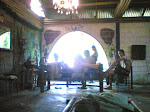.jpg)

